by Lorna McDowell // Nov. 21, 2023
“She found that her head was jutting forward uncontrollably,” an anonymous narrator reads over a cast of eerily child-like animated characters who smile, stutter and twitch their way through softly coloured scenes that are both familiar and surreal—an empty room, a kitchen sink, a shifting backdrop of leafy trees, punctuated by shots of a slowly pulsing electric fan. The embodied movements are subtle, contagious and controlled by invisible forces—a discreet smile or a yawn, a digging hand motion, the jerking of the dancing crowd at an underground party forming a sea of collective movement and emotion. For the 7-minute CGI animation, ‘Smile Driver’ (2019), Jessica Wilson mined motion data from the vast library of bodily movements uploaded to the internet by unknown authors, making her characters’ movements an amalgamation of human behaviour and desire. The work is also inspired by the phenomenon of somatic events like the The Dancing Plague of 1518 and the Twitching Teenagers in Le Roy, New York, in 2012.
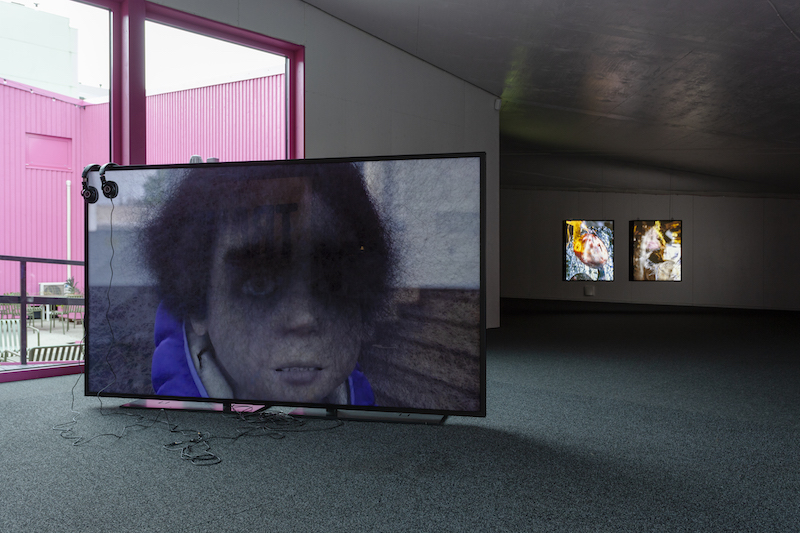
‘Trance,’ installation view at Tallinn Art Hall’s Lasnamäe Pavilion, the main exhibition of Tallinn Photomonth 23 // Photo by Paul Kuimet, courtesy of Tallinn Photomonth 2023
‘Smile Driver’ is a fitting entry point to the group exhibition ‘Trance,’ the main exhibition of the 7th edition of Tallinn Photomonth, an international biennial that now broadens its focus beyond photography to feature works of all disciplines that explore art and society in a world “increasingly mediated by cameras, screens and images.” The show’s curator, New York-based curator Ilari Laamanen, wants to draw our attention to the “charm and allure of being engaged with technology on one hand, and the darker side of these rapid developments on the other.” Situated just inside the main entrance of the Lasnamäe Paviljon, Wilson’s ‘Smile Driver’ lures us in immediately with a soft glow and animated textures that are detailed, smooth and satisfying, and characters who appear possessed both individually and collectively. In the societal context of our daily consumption of online videos, memes, social media and flows of information, Wilson depicts a trance that mirrors our own. The work also introduces another conceptual tool of the exhibition: “glitch.” Wilson’s wholesome, animated environment is interrupted by ripples under the pavement and backgrounds and sounds that stick for a moment. These glitches momentarily break the trance, calling attention to the antagonisms that exist between virtual and physical realms.
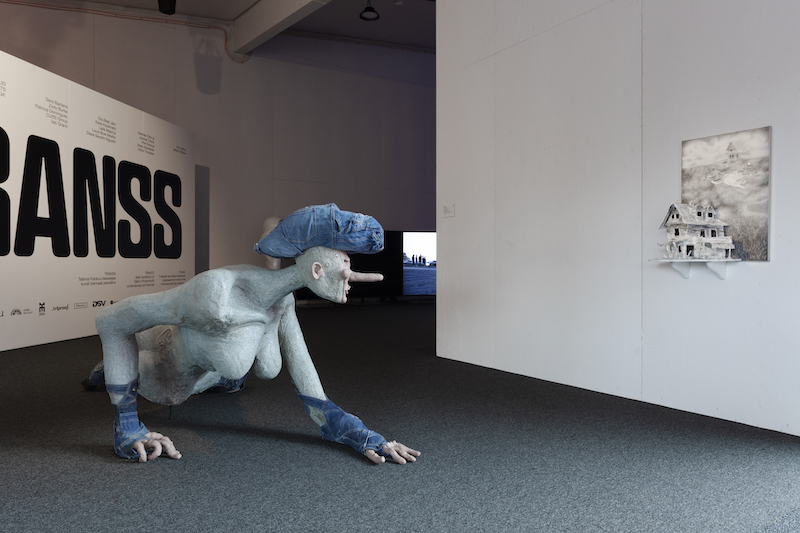
‘Trance,’ installation view at Tallinn Art Hall’s Lasnamäe Pavilion, the main exhibition of Tallinn Photomonth 23 // Photo by Paul Kuimet, courtesy of Tallinn Photomonth 2023
Sculpture, photography and video installations creep through the looped, corridor-like pathway of the Lasnamäe Paviljon—occupying its floor space and suspended from corners and high ceilings. Laamanen curated the show to exclude the usual lighting fixtures and traditional means of hanging. The artworks are self-lit or illuminated by the small amount of cold winter light that streams in through the front of the building, making the space dark and moody to walk through. There is a focus on video works, which are given sufficient breathing space from each other and bathe other nearby works with an additional oscillating light. The second work we encounter is the denim-clad and grotesquely feminine figure of Zody Burke’s newly-commissioned sculpture, ‘Christina’s Sacrifice’ (2023). The large-scale, gangly limbed figure crouches on the floor submissively and in longing towards the much smaller sculpture of a farmhouse nearby, emulating, in more horror movie fashion, a gesture from Andrew Wyeth’s 1948 painting ‘Christina’s World,’ one of the best known American paintings of the 20th century, and a scene from Soviet director Andrey Tarkovsky’s film ‘The Sacrifice’ (1986). The two contemporaries never met but both produced the same striking image, as if from a shared pool of global consciousness. As well as commenting on the hyper-sexualisation of the female body, the work communicates an important detail in the exhibition narrative: the far-reaching influence of US mass culture which, imbued with the ideals and obsessions of late-stage capitalism, lays the unsettling foundation for the technological trance we find ourselves in.
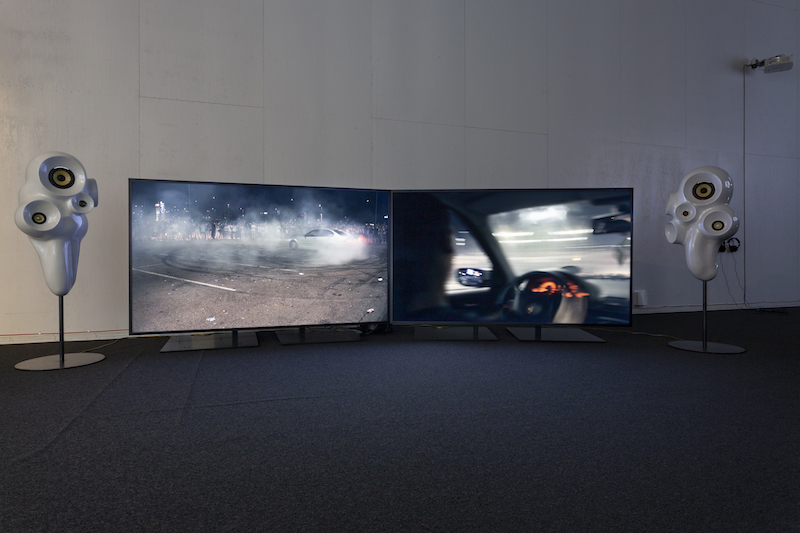
‘Trance,’ installation view at Tallinn Art Hall’s Lasnamäe Pavilion, the main exhibition of Tallinn Photomonth 23 // Photo by Paul Kuimet, courtesy of Tallinn Photomonth 2023
While some audio is channeled through headphones as part of an installation, sound from other works flows and echoes around the exhibition space—the ominous ticking of a clock is a continual backdrop that collides with the angry revving of car engines in Karel Koplimets’ two-channel video work, ‘Driven.’ Koplimets documents a subculture of car enthusiasts who gather en masse every Tuesday evening in the parking lot of a nearby shopping centre in Tallinn. Modified cars are altered with the finest attention to detail, enhanced to the hilt with booming audio systems, one vehicle proudly transformed into a doughnut-making facility. A male-dominated crowd mills around as engines rev and tyres screech, they gather in clusters around speakers that blast European dance-pop music, posturing and admiring each others’ creations while participating in illegal street races. The ear-piercing sounds and toxic machismo of the scenes are anxiety-inducing and intimidating, but Koplimets also captures a communal revelry at play. The vehicles are an extension of personal identity and body; a means of self-expression. The custom-designed speakers in the exhibition space, which form part of the video installation, are curved and smooth and reflect the light like one of the highly-polished cars in Koplimets’ footage. In a country that is big on cars—with 715 cars per 1000 people in Estonia, and the number of cars increasing globally despite the global climate crisis—Koplimets portrays loaded themes around masculinity, individuality and power, and the environmental costs of pleasure and consumption.
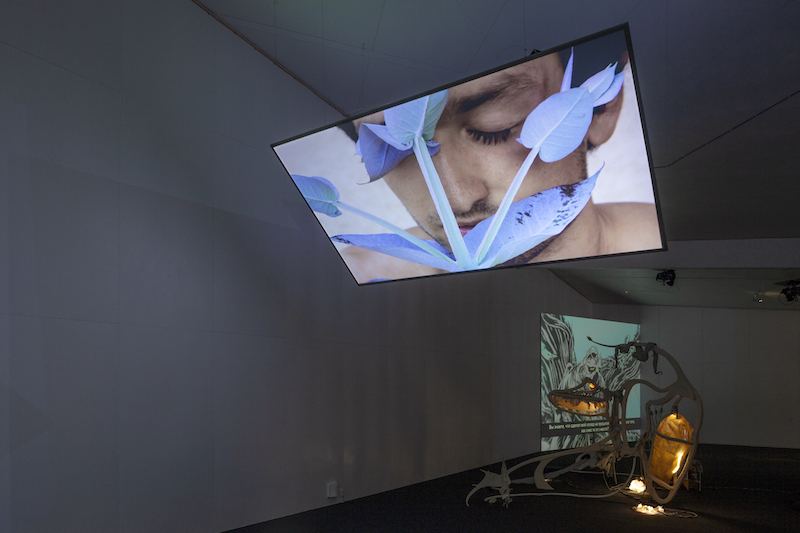
‘Trance,’ installation view at Tallinn Art Hall’s Lasnamäe Pavilion, the main exhibition of Tallinn Photomonth 23 // Photo by Paul Kuimet, courtesy of Tallinn Photomonth 2023
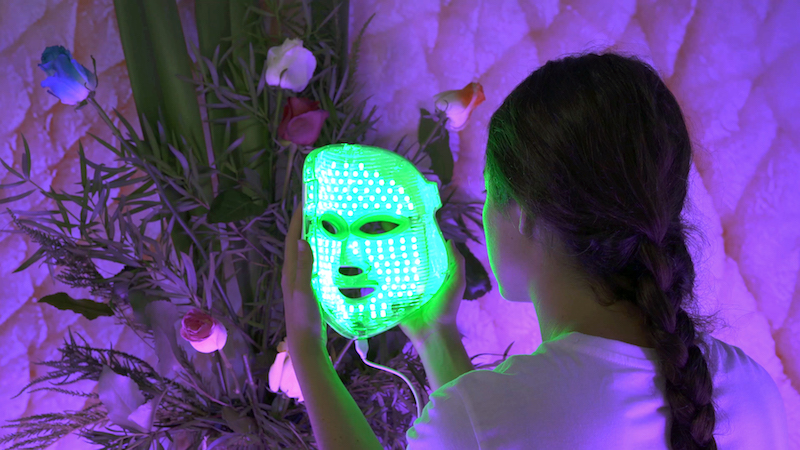
Patricia Dominguez: ‘Eyes of Plants,’ commissioned by Gasworks London, 2019 // Courtesy of the artist
Nearby, the video installation ‘Eyes of Plants’ (2019), by Chilean artist Patricia Domínguez, slows things down a notch, as visitors submerge themselves into bean bag chairs, laying back comfortably to watch the psychedelic 25-minute narrative on a screen suspended at an angle above. The work begins by calling in our slow attention, as geometric shapes and fractals swirl and kaleidoscope, from the details of a ‘Jarro Pato’–a Pre-Columbian duck-shaped vase “crying cosmic tears” and from Domínguez’s grandfather’s collection of pre-colonial artifacts. The zig-zag, ripple and chain-link patterns merge hypnotically with similar patterns from contemporary business shirts, which, for the artist, symbolise “a kind of psychic amulet for micromanaging the cosmic evils of capitalism.” The familiar sound of the vibration of a mobile phone occasionally disturbs an immersive ambient soundtrack, shaking us from the trance briefly. The video features the Chilean desert, cacti and Domínguez’s own family members, while an AI narrator describes the journey of ancestral DNA through saliva. It’s also rich with ritualistic imagery and symbols that allude to the parallel damages of colonialism and neoliberalism: the rose, which was introduced to South America by European settlers; a made-in-China LED therapeutic facemask; and photo-scanned 3D models of the artist’s green eyes, “a genetic residue of colonisation.”
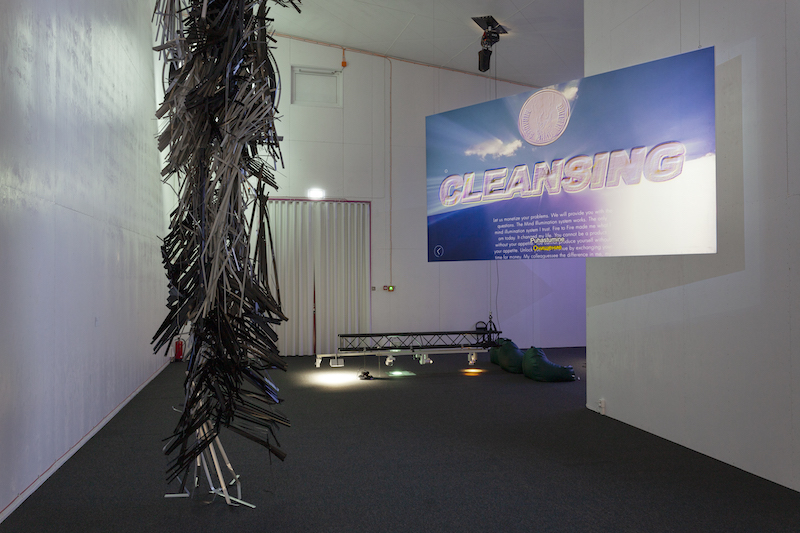
‘Trance,’ installation view at Tallinn Art Hall’s Lasnamäe Pavilion, the main exhibition of Tallinn Photomonth 23 // Photo by Paul Kuimet, courtesy of Tallinn Photomonth 2023
Moving through the dimly-lit exhibition, our attention is captured not only by the screens, but also by more tangible works: a sculpture made from found material that hangs like a dying office plant, the skeleton of a prehistoric looking creature made from natural materials and animated by technology, light projected unexpectedly from a lowered ceiling truss and fantastical leather sculptures created in 1984 that find resonance with the more contemporary work. The messages conveyed reflect the concerns and anxieties that permeate the collective consciousness of our screen-addicted society, and lure us, with the same tricks, into a consideration of critical parallels to the everyday feeds of information. It’s hard to look away, and we find ourselves in a collective trance, in the “intense focusing of attention” that Laamanen describes.
Exhibition Info
Tallinn Photomonth
Group Show: ‘Trance’
Exhibition: Oct.6-Nov. 26, 2023
fotokuu.ee
Lasnamäe Pavilion, Jaan Koorti 24, 13623 Tallinn, Estonia, click here for map






















